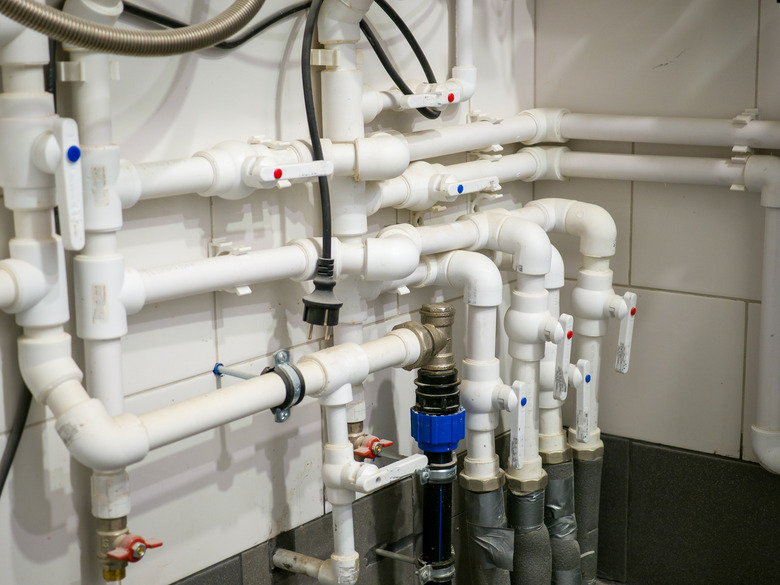How To Join A PVC Pipe With A CPVC Pipe
We may receive a commission on purchases made from links.
Plastic piping comes in a variety of chemical makeups, two of which are PVC (polyvinyl chloride) and CPVC (chlorinated polyvinyl chloride). These two are easily confused because their names contain two of the same words. The fact is they're very different with respect to chemical makeup and temperature threshold. Although joining the two together can be done, the question to ask is, should it be done? If you decide to for whatever reasons, understanding the precautions and differences is a must.
Applications and Differences
Applications and Differences
PVC is used mostly for drain piping and water supply piping where applications are below 140 degrees Fahrenheit. Anything above 140 F will cause the PVC to break down and start deteriorating. In most homes, water supply from the water heater stays below 140 F, but it can get close to this threshold, so PVC use is typically limited to drain and vent piping.
CPVC can withstand temperatures up to 200 F due to the extra chlorination process that's initiated by ultraviolet light. The normal use for CPVC is domestic water supply. Although it can be used for drainage, it's not as cost-effective as PVC.
Pipe Diameter Differences
Pipe Diameter Differences
Pipe sizes are measured based on the nominal inside diameter of the pipe being used, meaning a 1-inch pipe will have an approximate 1-inch inside diameter. The outside diameter varies by pipe material and is very different between PVC and CPVC pipe.
PVC is sized according to the Nominal Pipe Size (NPS) standard, while CPVC can be sized with the NPS or the Copper Tube Size (CTS) standard. NPS sizing for CPVC is rare and used in industrial applications. CTS and NPS sizing is not compatible. For example, a 1-inch PVC pipe has an outside diameter of 1 5/16 inches (NPS); a 1-inch CPVC pipe has an outside diameter of 1 1/8 inches (CTS). This size difference makes joining the NPS and CTS pipes impossible without a special transition fitting.
Choosing the Right Glue
Choosing the Right Glue
Gluing PVC and CPVC pipes together isn't as simple as putting the glue on the fittings and sticking them together — there are more steps involved. First, you need the right primer and glue, or solvent cement, for the job. Solvent cement softens the plastic materials through a chemical process, and this is what creates the glue bond. CPVC pipe needs stronger chemicals to soften it during the priming and gluing process, so when joining CPVC to PVC, you need to use a primer and cement formulated for CPVC.
Although there is a universal cement that is formulated for both PVC and CPVC which does make it a little easier depending on your use of the piping, the specific temperature range of this cement is well below the rating of CPVC piping. Glue manufacturers recommend using the right glue for the right application.
Different Mechanical Connections
Different Mechanical Connections
The most common method for joining PVC and CPVC is to create a mechanical joint with a male threaded pipe fitting glued to one pipe and a female threaded pipe fitting glued to the other pipe; then the pipes are joined with the threaded fittings. Another way is to use two male connections connected by a pipe union or threaded coupling. Either way, it's going to require a few simple tools and thread-seal tape or other suitable sealant.
Making the Connection
1. Prime the Joint
Clean the pipe; then brush the CPVC primer on the outside of the pipe and also on the inside of the fitting to make your transition.
2. Glue the Joint
Brush the outside of the pipe and inside of the fitting lightly with CPVC glue/cement.
3. Join the Fitting to the Pipe
Quickly slide the pipe into the fitting, giving the pipe a quarter-turn twist inside the fitting. This spreads the glue between the two fittings, creating the bond.
4. Hold the Fitting and Pipe Together
The fitting and pipe will want to slip apart from each other. Make sure to hold the joint together for about 30 seconds before letting it go. Repeat steps 1 through 4 to glue a second fitting onto the other pipe.
5. Thread the Connections
Wrap the male threads with Teflon tape or apply thread sealant and tighten the fittings together with a wrench or pliers.
Quick Nongluing Method
Quick Nongluing Method
There's an even quicker method for joining PVC to CPVC, using push-fit, or push-to-connect, fittings. These special fittings come in a variety of configurations and connection types, so find the fitting that's suitable for your application, and follow the instructions on the packaging. All it takes to make a connection is making a square cut on each pipe section, cleaning the cut end to remove burrs, marking the full-insertion depth of the fitting onto the pipe, and pushing the fitting onto the pipe (or inserting the pipe into the fitting) all the way, until the fitting reaches the insertion mark.
